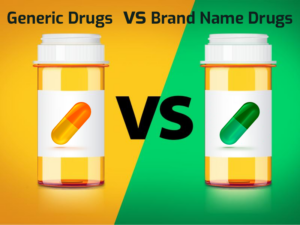Last updated on September 26th, 2024 at 04:19 pm
Generic and brand medicines play a pivotal role in healthcare by providing patients with effective treatment options for various medical conditions. However, a notable difference often observed between these two types of medications is their appearance. Generic drugs and brand-name drugs can often look distinct from each other, raising questions about why this visual dissimilarity exists.
Reason for Generic and Brand Medicines having a different look
These two types of medicines often appear different due to a combination of factors related to their production, regulations, and marketing strategies. Here are the key reasons why these two types of drugs may have distinct appearances:
- Regulatory Requirements: Generic drugs are required to demonstrate bioequivalence to their brand name counterparts. This means that they must have the same active ingredient, strength, dosage form, and route of administration as the brand name drug. However, they are not required to replicate the exact appearance, colour, or shape of the brand name drug. Regulatory agencies, such as the Central Drugs Standard Control Organisation(CDSCO), focus more on ensuring that the generic medicine performs in the same way as the brand name drug, rather than on its physical appearance.
- Patents and Intellectual Property: Brand name drugs are often protected by patents that grant the original pharmaceutical company exclusive rights to produce and market the drug for a certain period. During this time, the brand name drug’s appearance is carefully crafted to reflect the company’s branding and image. Once the patent expires, other manufacturers can produce generic versions of the drug. While these generics must meet the same quality and efficacy standards, they can have different appearances as long as they meet regulatory requirements.

- Manufacturing Processes: Generic drug manufacturers may use different processes and formulations to create drugs with the same active ingredient as the brand name drug. These variations can lead to differences in the final product’s appearance, such as colour, shape, size, and markings. These changes do not affect the drug’s safety or effectiveness, as long as the generic drug meets bioequivalence standards.
- Cost Considerations: One of the main advantages of generic drugs is their cost-effectiveness compared to brand name drugs. Generic medicine manufacturers often aim to minimize production costs, which can influence their choices in terms of appearance. They might opt for simpler and more cost-efficient production methods, which could result in variations in appearance.
- Consumer Perception and Marketing: Brand name drugs often invest in elaborate branding and marketing efforts to establish a recognizable and appealing appearance. This can influence patients’ perceptions of the drug’s quality and efficacy. Generic drugs, on the other hand, might have a less distinct appearance to emphasize their focus on affordability and accessibility rather than branding.
- Differences in Inactive Ingredients: While generic drugs must have the same active ingredient as the brand name drug, they might contain different inactive ingredients. These inactive components can affect the appearance, taste, texture, and overall presentation of the drug.
> Consult a doctor and Order Medicine Online
Generic vs Brand Name Medicines
The differences in appearance between generic and brand-name medicines, often referred to as Generic vs brand-name medicines, are primarily driven by regulatory requirements, manufacturing processes, intellectual property considerations, cost factors, and marketing strategies. While these visual differences can sometimes lead to questions or concerns among patients, it’s important to recognize that generic medicines are rigorously tested and approved by regulatory agencies to ensure their safety, quality, and effectiveness.
Read: What is Generic Medicine?
FAQs on Generic and Brand Medicines
Q1. Why do generic and brand name medicines have different appearances?
Generic and brand medicines often have different appearances due to several factors. Generic drugs are developed and approved once the patent protection for the original brand-name drug expires. While both types of medications contain the same active ingredient, they might differ in inactive ingredients, formulations, and manufacturing processes.
These variations are permissible as long as the generic medicine meets strict regulatory guidelines for safety, efficacy, and quality. Additionally, branding and marketing strategies influence the visual design of brand-name drugs, leading to differences in colour, shape, and packaging when compared to their generic counterparts.
Q2. Are the visual differences between generic and brand medicines significant in terms of effectiveness?
No, the visual differences between generic and brand medicines do not significantly impact their effectiveness. Regulatory agencies, such as the CDSCO, require generic drugs to demonstrate bioequivalence to the brand-name drugs, meaning they deliver the same therapeutic effect in the body. While generic drugs may have distinct appearances due to variations in inactive ingredients and manufacturing processes, these differences have no bearing on their safety, quality, or efficacy.
Patients can trust that generic medicines, despite their visual dissimilarities, have undergone rigorous testing and approval processes to ensure their equivalence to brand-name medicines.
Related Links:
